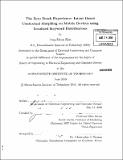| dc.contributor.advisor | Glen Urban. | en_US |
| dc.contributor.author | Kim, Jong-Moon, M. Eng. Massachusetts Institute of Technology | en_US |
| dc.contributor.other | Massachusetts Institute of Technology. Dept. of Electrical Engineering and Computer Science. | en_US |
| dc.date.accessioned | 2011-02-23T14:22:51Z | |
| dc.date.available | 2011-02-23T14:22:51Z | |
| dc.date.copyright | 2010 | en_US |
| dc.date.issued | 2010 | en_US |
| dc.identifier.uri | http://hdl.handle.net/1721.1/61164 | |
| dc.description | Thesis (M. Eng.)--Massachusetts Institute of Technology, Dept. of Electrical Engineering and Computer Science, 2010. | en_US |
| dc.description | Cataloged from PDF version of thesis. | en_US |
| dc.description | Includes bibliographical references (p. 45). | en_US |
| dc.description.abstract | With the rise of smart phones integrated with GPS devices, we have seen the advent of location-based contextual services. "Contextual" in this sense, refers to a simple query of nearby points of interest based on the current location. This type of filtering is but the most rudimentary of what can be done with such information. Depending on if the user is at the location because of recreation or work, the phone should provide varying services appropriate for that purpose. In this thesis, I present a technique to perform inference on user purpose and an implementation of that technique in a demonstration application called Concierge. Concierge showcases how purpose can be used to provide a compelling, personal mobile experience. The application uses a Bayesian inference system with Gittins index utilizing location, past behavior, search queries, as well as other data present on the phone to make an assessment about the user's purpose. Using this data, the application assembles the most relevant applications, offers deals and discounts for appropriate nearby businesses, and shows information about the user's friends and their statues. With Concierge, the most interesting content simply appears without any user input; hence the Zero Touch Experience. I discuss how such an inference system is designed and how it was implemented in a first-stage demonstration for France Telecom/Orange and then explore the implications as it pertains to mobile applications, mobile advertisement, and social interaction. | en_US |
| dc.description.statementofresponsibility | by Jong-Moon Kim. | en_US |
| dc.format.extent | 45 p. | en_US |
| dc.language.iso | eng | en_US |
| dc.publisher | Massachusetts Institute of Technology | en_US |
| dc.rights | M.I.T. theses are protected by
copyright. They may be viewed from this source for any purpose, but
reproduction or distribution in any format is prohibited without written
permission. See provided URL for inquiries about permission. | en_US |
| dc.rights.uri | http://dspace.mit.edu/handle/1721.1/7582 | en_US |
| dc.subject | Electrical Engineering and Computer Science. | en_US |
| dc.title | The Zero Touch Experience : intent based contextual morphing on mobile devices using localized keyword distributions | en_US |
| dc.title.alternative | Intent based contextual morphing on mobile devices using localized keyword distributions | en_US |
| dc.type | Thesis | en_US |
| dc.description.degree | M.Eng. | en_US |
| dc.contributor.department | Massachusetts Institute of Technology. Department of Electrical Engineering and Computer Science | |
| dc.identifier.oclc | 698462196 | en_US |
